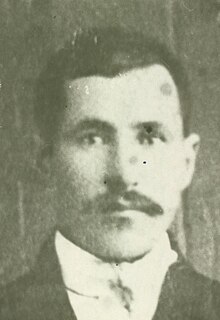Anarchism in Mongolia
| Part of a series on |
| Anarchism |
|---|
 |
Anarchism in Mongolia was present during the revolutionary period of the
.History
From the 19th century onwards, Mongolia acted as a refuge for Russian and Chinese revolutionaries, fleeing persecution by their respective empires. Many anarchists were drawn there by the freedom that the wide open spaces of the sparsely-populated plateau afforded to them.[1][2]
With the
At the turn of 1918, anarchist detachments began to form in Siberia, including a cavalry division led by
Pavel Baltakhinov, a Buryat anarchist who had been agitating against the Russian State as part of an anarcho-communist group in Irkutsk, fled from the White Terror in early 1919 and went into hiding in Mongolia. During his stay, Baltakhinov participated in anarchist agitprop among the local Mongols, such that when he returned to Siberia in August 1919, he brought many Mongols along with him, where they joined the anarchist guerillas led by Kalandarishvili.[15] He eventually came to command a Buryat guerilla detachment,[16][17][18][19] made up of 50-60 people.[20]

In

Nevertheless, forms of
The Arats, who were being marginalized by the nobility and party officials, continued to push for social reforms - even managing to achieve some in Tuva.[29] However, the nobility continued to hold onto power and the feudal marginalization of Arats continued. In response, many Arats formed Chuduruk Nam, an armed anarchist militant group[30][31] with the goal of protecting the Arats from the oppressive practices of the nobility and party officials. The organization confiscated cattle and property from the wealthy, attacked corrupt party officials, encouraged free love and promoted sanitation and hygiene.[32]
In March 1924, a counter-revolutionary insurrection was incited by the local nobility and clergy, aiming for a return to traditionalist values.[33] Supported by the Mongolian government, it demanded Tuva be annexed into the Mongolian state,[34] but the insurrection was quickly put down by the intervention of the Soviet Union, a Tuvan government detachment and squads of volunteer Arats.[35] Despite the role that Arats played in putting down the insurrection, the government blamed radical Arat activists for the situation, alleging that Chuduruk Nam had provoked it. As a result, Arat party officials were removed from their posts, including the Tuvan party chairman Oyun Kyursedi.[36] In December 1924, the Chuduruk Nam detachment was surrounded by government forces in the Ulug-Khem Valley and forcibly disarmed.[37]
With the elimination of the remaining left-wing opposition, the ruling parties of Mongolia and Tuva consolidated their power, overseen by the
See also
References
- OCLC 28393445.
- OCLC 53304465.
- OCLC 654657512.
- OCLC 36304446.
- OCLC 1038162462.
- OCLC 1075211.
- ^ "Центросибирь". Slownik.ru. Archived from the original on September 28, 2007.
- ^ Lenin, Vladimir (April 5, 1918). "59. TELEGRAM TO THE C.E.C. OF THE SOVIETS OF SIBERIA". Translated by Clemens Dutt.
- OCLC 43257523.
- ^ OCLC 654657512.
- OCLC 1034854159.
- OCLC 654657512.
- ^ OCLC 1170631123.
- ^ Marmyshev, А.V.; Eliseenko, А.G. (2008). Гражданская война в Енисейской губернии. Krasnoyarsk. pp. 165–168, 174–179.
{{cite book}}: CS1 maint: location missing publisher (link) - ^ a b Moenhbayar, Ch. (13 April 2011). "Буриад Балтахинов Ар Монголд анархист үзлийг дэлгэрүүлж явжээ" (in Mongolian). Ulaanbaatar. Retrieved 4 February 2021.
- OCLC 690446020.
- ^ Egunov, Nikifor Petrovič (1979). Павел Балтахинов. Irkutsk.
{{cite book}}: CS1 maint: location missing publisher (link) - OCLC 36304446.
- ^ Basayev, Sergey (17 November 2014). "Мог бы стать священником" (in Russian). Интернет-газета Республики Бурятия. Retrieved 4 February 2021.
- OCLC 900162070.
- OCLC 603762073.
- OCLC 234204057.
- OCLC 490109656.
- OCLC 1038162462.
- OCLC 611618490.
- OCLC 569725662.
- OCLC 47198036.
- OCLC 431401855.
- OCLC 977796339.
- OCLC 493363539.
- OCLC 3065280.
- OCLC 665169807.
- OCLC 665169807.
- OCLC 607278225.
- OCLC 913131005.
- OCLC 493363539.
- OCLC 1077121284.
